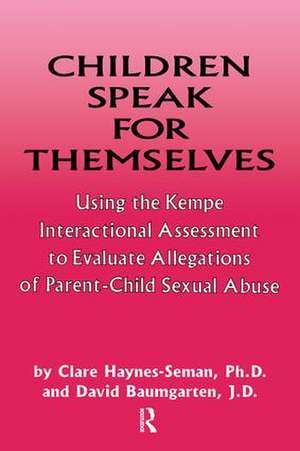Children Speak For Themselves: Using The Kempe Interactional Assessment To Evaluate Allegations Of Parent- child sexual abuse
Autor Clare Haynes-Seman, David Baumgartenen Limba Engleză Paperback – 17 ian 2019
Preț: 257.62 lei
Preț vechi: 271.17 lei
-5% Nou
Puncte Express: 386
Preț estimativ în valută:
49.29€ • 51.61$ • 40.79£
49.29€ • 51.61$ • 40.79£
Carte tipărită la comandă
Livrare economică 07-21 aprilie
Preluare comenzi: 021 569.72.76
Specificații
ISBN-13: 9781138869332
ISBN-10: 1138869333
Pagini: 214
Dimensiuni: 152 x 229 x 18 mm
Greutate: 0.3 kg
Ediția:1
Editura: Taylor & Francis
Colecția Routledge
Locul publicării:Oxford, United Kingdom
ISBN-10: 1138869333
Pagini: 214
Dimensiuni: 152 x 229 x 18 mm
Greutate: 0.3 kg
Ediția:1
Editura: Taylor & Francis
Colecția Routledge
Locul publicării:Oxford, United Kingdom
Public țintă
Professional Practice & DevelopmentNotă biografică
Haynes-Seman, Clare; Baumgarten, David
Cuprins
Chapter 1 1 How to Turn a Problem into a Solution; Chapter 2 2 Design for a Complete and Objective Process: How to Get All the Information You Need; Chapter 3 3 Evaluation Tasks, Skills, and Pitfalls; Chapter 4 4 A Parent's Unresolved Childhood Trauma: Variations on a Theme; Chapter 5 5 Mothers and Grandmothers: Thinking the Unthinkable; Chapter 6 6 Children Speak Through Metaphors, Stories, and Drawings; Chapter 7 7 Children Speak Through Behavioral Reenactments; Chapter 8 8 Behavioral Clues to Experiences; Chapter 9 9 Children Speak Through Words, Behavior, and Symbolic Play; Chapter 10 10 Opportunities for the Helping ProfessionsReferences; Index;
